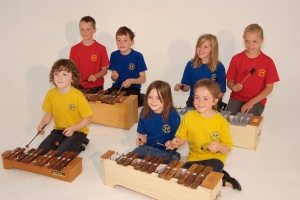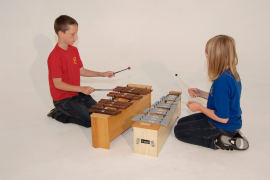Solfa is the visualisation in space of tonal relationships and it WORKS with children!
Solfa gives a half-way house between symbols on a piece of paper and the sound that comes out of your mouth. What’s more, you can give the hand signs characters!
If you have stayed away from solfa and hand signs thinking it’s too complicated, it’s actually really EASY and a great way in for teaching in-tune singing with children! It’s great to start with the first five notes of the pentatonic scale. You can watch the children learning these hand signs with the characters in our videos right now if you would like to and see how it helps them with learning about singing in tune and intervals.

SOPHIE is the first one we teach and we describe her like this! Sophie is a pretty little girl who likes looking at herself in the mirror! (This indicates to hold your hand in such a way that you could see yourself if looking in a mirror).
Sophie like to be called ‘So’ for short.

MIKHAIL is the next. We tell the story that Mikhail is best friends with Sophie (always both on lines or in spaces when written – knowledge for later) but that Mikhail doesn’t care what he looks like and puts the mirror flat on the table (indicating the hand being flat as if on a surface and lower than eye level) and goes running off to play in the woods!
Mikhail likes to be called ‘Mi’ for short.

LARA is the third. Lara is friends with Sophie and Mikhail though not as close. Lara is very way out, likes hanging around in trees (hence the overhanging hand sign), wearing purple and going to discos.
Lara likes to be called ‘La’ for short.

Fourth, there is DODI – Dodi is a very solid, dependable and kind lady (hence the hand sign depicting a solid base) who works in a local café. She always gives children free cups of tea and pieces of cake on their way home from school and listens to all their problems. She is really really kind and always there.
Dodi likes to be called ‘Do’ for short.

Lastly there is RAYMOND. Raymond works with Dodi in the café and they are close. The only thing we know for sure about Raymond is that he lives on a hill (hence the gradient of the hand sign). Some people think that he is in a relationship with Dodi but no-one is completely sure!!
Raymond likes to be called ‘Re’ for short.
It’s a great idea to teach songs on So and Mi first, then introduce the children to the hand signs and the characters. Next it’s a good idea to teach La, So, Mi songs and introduce Lara, then So, Mi, Do to introduce Dodi and Mi, Re, Do to introduce Raymond! Everyone probably does this slightly differently but this process has always worked for me! The characters have always been key, too, for the children remembering the notes and their signs and their relationships to each other. None of these characters are set in stone and can be re-written or interpreted in different ways.
Once the children know these notes they can sight sing them when written under stick notation (rhythms) and can compose with both rhythms and melody. It opens up a whole world of musical knowledge which can be expanded to compositions and improvisations. It’s a great way for children to own what they are learning musically and to enjoy the process.
In Active Music Digital the hand signs are all demonstrated on DVD as part of a set of over 600 DVD tracks all available instantly online so you can learn this process, amongst others, and implement it immediately with your children! Your children in the classroom can watch the DVDs too via the interactive whiteboards, which can help teachers who struggle with confidence!
We would love to hear from you here at http://www.activemusicdigital.co.uk. Please feel free to sign up for a FREE TRIAL and access all 600 DVD tracks instantly. You can also download 40 lesson plans to get an idea of how it all works. We look forward to seeing you there!
Happy Music Teaching!
PS To access the free trial take the following steps:
- Go to http://www.activemusicdigital.co.uk
- Click on start a free trial
- Submit your details
- Find the email in your inbox with the activation link
- Click on the link and you will be re-directed to a page where you will find your username and password in the left top.
Enjoy!




















